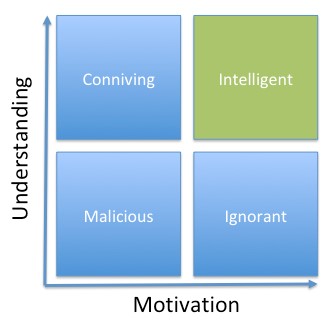Process – the good the bad and the ugly
When you mention processes some people have an image of an overly bureaucratic monster, eating your time and energy as well as stifling creativity. However, processes are essential to achieve outcomes in projects where many people need to know what to do to get stuff done, how to co-ordinate with others, and where good practice and lessons learned need to be embedded. Processes are the enablers of any bureaucracy; they are the necessary structure of any project or organisation.
Lack of creativity
Processes also have a downside – they can be seen to grow unchecked and stifle innovation, creativity and the flexibility of a project. Sometimes they are developed in response to an incident, audit or review without thinking through the full consequences of their impact, so as they fix one problem they create another. This can mean they do not allow the people in an organisation to perform as well as they might do. In the past, a small number of over zealous quality assurance groups developed a reputation for having processes for everything, whether they added value or not. If there was an activity, there needed to be a process to control it and to tell people how to do it. A by-product of having many processes is that it is difficult to know them all. And so when people are reviewed for compliance against them, they are found wanting. This develops a downward spiral of compliance checking, process updating, and the development of more process furring up the arteries of the organisation when they should be its way of getting things done.
The culture of an organisation or project is a key determinant in how people use processes. Those projects in heavily regulated industries or governments, where transparency and demonstrable impartiality are needed, tend to have a greater reliance on processes. These processes provide the governance needed to comply with regulations or to ensure that their operations are safe. One of the issues with this culture is that no process can account for every scenario; there will be some circumstances where the process does not work as intended and the outcome needed is not achieved.
Lack of agility
For many projects as they move from merely complicated to complex, sensing and responding quickly and flexibly to change become more and more important, some processes can inhibit this, or at best slow it down. It is because of the above that no matter how many statements are included about how “processes may be adapted as long as it is agreed in the quality plan”, people will either not have the confidence, ability or willingness to do this. This environment and lack of sensible application leads to several ways in which people will comply with processes.
Four types of compliance:
Ignorant – This is where people will follow a process to the letter, but not achieve the outcome. This may be because they have not been trained or educated on the concepts and context of the process, therefore cannot make any judgement about how the process can support them in achieving their objective
Malicious – A more sinister compliance is where people do understand the context and the concepts and are aware that following the process will not support them achieving their objective. They follow the process because they have been told to but are not trusted or supported to use their own initiative to achieve the outcomes. Any variance from process has been punished in the past, or has the prospect to be in the future. This form of compliance is most common in command and control, and safety cultures.
Conniving – This is another form of sinister compliance, where the objectives of the process are known but they are not aligned with the objectives of the individual. The individual uses their creative energies to achieve their own ends by complying with the letter of the process, but not the intent. This Machiavellian compliance is again common in command and control organisations, and in environments where there is malicious compliance.
Intelligent – This form of compliance is the objective of any organisation. This is where people exercise their intelligence, creativity, and judgement to achieve the intended outcomes of the process within the spirit in which it was written. This is where the rules are adapted in a transparent way under the appropriate governance.

The ultimate goal of any process compliance is to have people comply with the intent as no process or design can anticipate all the scenarios they will encounter and so must be able to adapt to the situation.
To move people towards intelligent application, from conniving, malicious or ignorant compliance, two ingredients are needed. The first, and perhaps the easiest, is people need to understand the processes and how they fit into the wider organisation. Briefings and some training can achieve this understanding. This move towards intelligent application assumes of course that the processes are efficient and meet the majority of the needs of the business. As any lean six sigma practitioner will tell you, processes can always be improved. This is why a degree of flexibility has to be built into their application and people given the ability to adjust them, under agreed controls, to meet the business needs.
The second driver is the motivation, the desire to comply in an intelligent way, rather than use this intelligence and creativity to find a way round the process or subvert the objective. There are a variety of ways that this can be achieved, some overlapping with the briefings needed for understanding where not only do people need to understand the what, but why as well. Why this is important, and what value it adds to the outcomes of the project and to their role within achieving this. A key way in which people can be motivated is to have the leadership follow the process and set an example and so develop a culture of intelligent application.
Processes are the vital enablers to the successful implementation of any project. They can embody good industry practice and as long as they are used intelligently they provide a platform for innovation and creativity and deal with the complexity of many modern projects. This intelligent use takes leadership, the application of effort and the willingness to listen and act on feedback, which is, after all, what project delivery is all about.


1 comments
Log in to post a comment, or create an account if you don't have one already.
An excellent piece Alistair, and I coming from a world where we develop, embed processes recognise each of the stages articulated in your blog. Fully agree on the intelligent approach but would caveat that any intelligent development, execution embedding of process must be measured for enduring capability - measuring the right churn and outcomes should provide the goodness or quality of its execution. Great read thanks